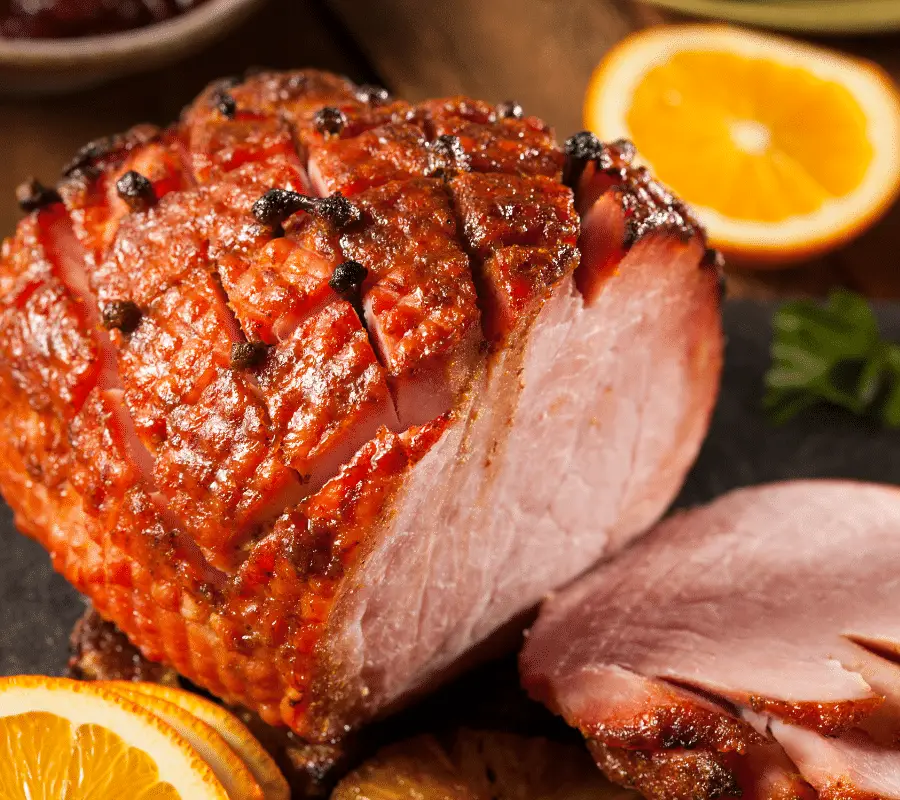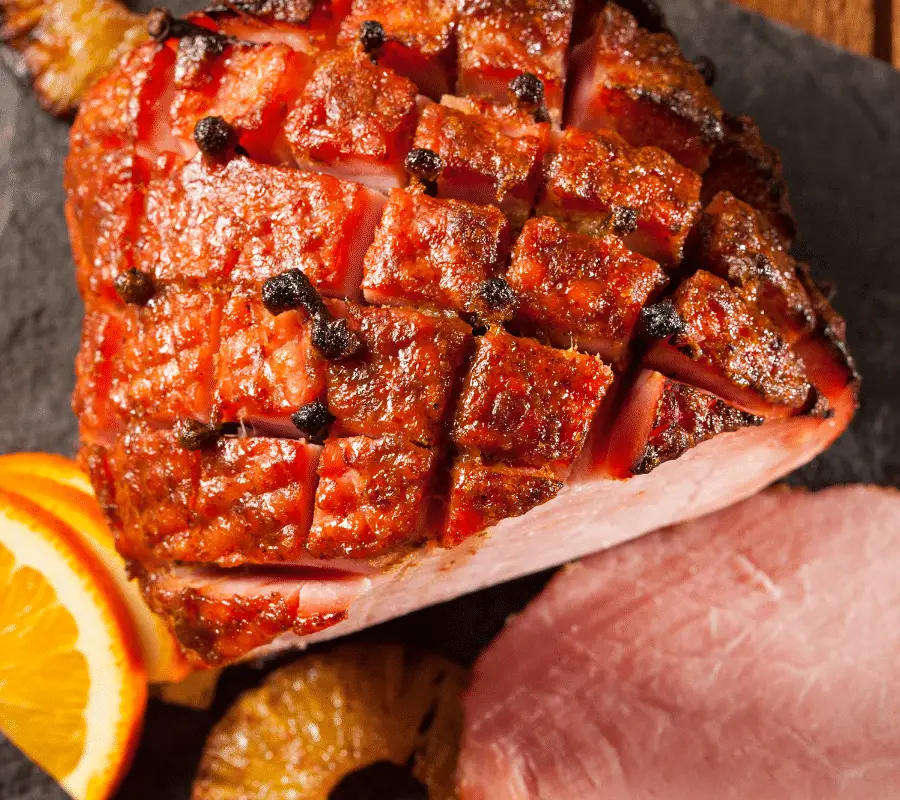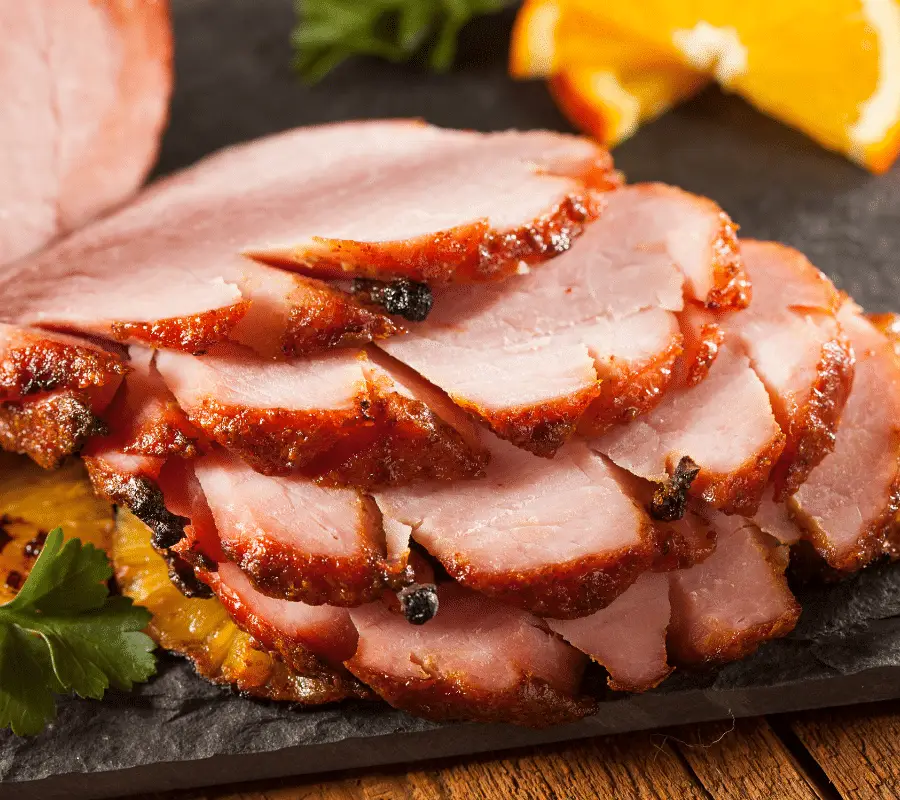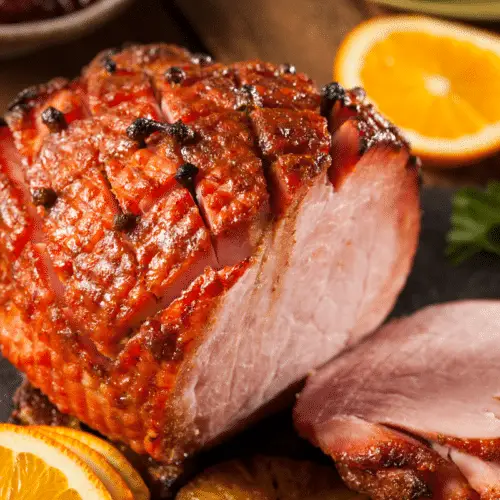How To Make Glaze For Gammon: A Simple Guide
Gammon is a classic dish that is often served on special occasions, such as Christmas or Easter. One of the most important steps in preparing gammon is making the perfect glaze. A good glaze can elevate the flavour of the gammon and make it truly unforgettable. There are many different types of glazes that can be used for gammon, ranging from sweet and sticky to tangy and savoury. Some popular ingredients for gammon glazes include honey, brown sugar, mustard, and fruit preserves. The key is to find a combination of flavours that complements the saltiness of the gammon without overpowering it. With the right glaze, gammon can be transformed into a truly show-stopping dish that will impress any guest.

Easy glaze for gammon joint
Gammon is a popular meat dish that is often served during special occasions and holidays. It is essentially a cured ham that is typically served with a sweet glaze to add flavour and moisture to the meat. Making the perfect glaze for gammon can be a bit intimidating, but it doesn’t have to be. With the right ingredients and techniques, anyone can make a delicious glaze for their gammon.
There are many different types of glazes that can be used for gammon, ranging from sweet and fruity to tangy and savoury. Some popular options include honey glaze, fruit glaze, brown sugar glaze, and mustard glaze. The key to making a great glaze is to balance the flavours and ensure that it complements the gammon without overpowering it.
In this article, we will explore some of the best recipes and techniques for making a glaze for gammon. Whether you prefer a classic honey glaze or something more unique, we’ve got you covered. By following our step-by-step instructions, you’ll be able to make a delicious and flavorful glaze that will take your gammon to the next level.
Why Use a Glaze for Gammon?
Gammon is a delicious cut of meat that is perfect for any occasion. However, it can be quite salty and bland on its own. This is where a glaze comes in handy. A glaze is a sweet and savoury mixture that is brushed over the gammon before baking. It not only adds flavour and moisture but also gives the gammon a beautiful golden colour.
Glazes come in many different flavours and varieties, from classic honey and mustard to more exotic flavours like ginger and pineapple. They can be made with a variety of ingredients, including sugar, honey, mustard, maple syrup, and even cola. The possibilities are endless, and you can experiment with different flavours until you find your perfect glaze.
Using a glaze also helps to keep the gammon moist while it cooks. The sugar in the glaze caramelizes and creates a sticky, flavorful coating that helps to seal the juices. This means that your gammon will be tender and succulent, with a deliciously crispy exterior.
Overall, using a glaze is a great way to elevate your gammon and make it truly special. It adds flavour, moisture, and visual appeal, making it the perfect centrepiece for any meal.
Types of Crackling for Glazed Ham
Crackling is a popular addition to glazed ham, and there are several types to choose from. Here are some of the most popular types:
- Traditional: This is the classic crackling that most people are familiar with. It is made by scoring the skin of the ham and then roasting it until it is crispy and golden brown.
- Candied: Candied crackling is made by brushing the ham with a sweet glaze and then roasting it until the crackling is crispy and caramelized.
- Spiced: Spiced crackling is made by rubbing the ham with a mixture of spices before roasting it. This can include anything from cinnamon and nutmeg to paprika and cayenne pepper.
- Smoked: Smoked crackling is made by smoking the ham before roasting it. This gives the crackling a rich, smoky flavour that pairs well with the sweet glaze.
When choosing a type of crackling for your glazed ham, it’s important to consider the flavour profile of the glaze. For example, if you are using a sweet glaze, you may want to opt for a traditional or candied crackling. If you are using a savoury glaze, spiced or smoked crackling may be a better choice.
Ultimately, the type of crackling you choose will depend on your personal preference and the flavour profile of your glaze. Don’t be afraid to experiment with different types to find the perfect combination for your glazed ham.

What type of gammon to choose for cooked ham
When choosing gammon for cooked ham, there are a few things to keep in mind. First, it’s important to choose the right size of gammon for your needs. A good rule of thumb is to allow approximately 200g per person, so if you’re feeding a family of four, you’ll need a gammon joint that weighs around 800g.
When it comes to choosing the type of gammon, there are a few different options available:
- Smoked gammon: This type of gammon has been cured and then smoked, giving it a rich, smoky flavour. It’s a great choice if you want to add extra depth of flavour to your cooked ham.
- Unsmoked gammon: If you prefer a milder flavour, unsmoked gammon is a good choice. It’s been cured but not smoked, so it has a more subtle taste.
- Bone-in gammon: Gammon joints can come with or without the bone. A bone-in joint will take longer to cook, but it can add extra flavour to your cooked ham.
- Boneless gammon: A boneless joint is easier to carve and will cook more quickly, but it may not have quite as much flavour as a bone-in joint.
Ultimately, the type of gammon you choose will depend on your personal preferences and the recipe you’re using. If you’re unsure, it’s always a good idea to ask your butcher for advice.
Ingredients for gammon glaze
Making a delicious glaze for gammon requires only 2 key ingredients. Here are the ingredients you will need:
- 3 tbsp English Mustard
- 90 g Soft Brown Sugar
Optional extras
- Cider or apple juice
- Honey
- Apple cider vinegar
- Syrup
These ingredients will give your gammon a sweet and tangy glaze with just the right amount of spice. You can adjust the ingredients to your liking, but be sure to keep the brown sugar as the base for the glaze.
When selecting your ingredients, be sure to choose high-quality brown sugar. You can also use different types of mustard or vinegar to add your own unique twist to the glaze. Experiment with different spices to find the perfect combination for your taste buds.
Now that you have your ingredients, it’s time to start making the glaze. Follow the instructions in the next section to create a mouth-watering glaze for your gammon.
Instructions
Here are the step-by-step instructions for making a delicious glaze for gammon:
- Preheat your oven to 180°C (160°C fan)/350°F/gas mark 4.
- Cut away the skin with a sharp knife, leaving behind a thin layer of fat. Discard the skin.
- Score the fat all over in a diamond pattern so that the glaze can penetrate the fat.
- In a small bowl, mix together the ingredients for the glaze. You can use honey, mustard, brown sugar, pineapple juice, orange juice, or any combination of these ingredients.
- Brush the glaze all over the gammon, making sure to get it into the scored fat.
- Cover the gammon with foil and place it in the oven.
- Bake for 20 minutes per 450g (1lb) of gammon, basting with the glaze every 20 minutes.
- Remove the foil for the last 20 minutes of cooking to allow the glaze to caramelise and the fat to crisp up.
- Once cooked, remove the gammon from the oven and let it rest for 10-15 minutes before carving.
And that’s it! With these simple instructions, you can make a delicious glaze for your gammon that will impress your guests and leave them wanting more.

Tips and Variations
When making a glaze for gammon, there are a few tips and variations that can make your dish stand out. Below are some ideas to try:
- Try different sweeteners: While most gammon glaze recipes call for honey or brown sugar, you can experiment with other sweeteners like maple syrup, agave nectar, or even fruit preserves.
- Add spices: To give your gammon a little kick, try adding some ground cinnamon, nutmeg, or cloves to your glaze. You can also add some heat with a pinch of cayenne pepper or red pepper flakes.
- Use different mustards: English mustard is a popular choice for gammon glazes, but you can also try dijon or whole-grain mustard for a different flavour.
- Get creative with herbs: Fresh herbs like rosemary, thyme, and sage can add a delicious aroma and flavour to your gammon. You can also try using dried herbs like oregano or basil.
Remember to taste your glaze as you go and adjust the seasoning to your liking. And don’t be afraid to get creative and come up with your own unique glaze recipe!

How To Make Glaze For Gammon: A Simple Guide
Equipment
Ingredients
- 3 tbsp English Mustard
- 90 g Soft Brown Sugar
Instructions
- Cut away the skin with a sharp knife, leaving behind a thin layer of fat. Discard the skin.
- Score the fat all over in a diamond pattern, so that the glaze can penetrate the fat.
- Spread a layer of mustard over the fat, using a palette knife or your hands. Add more mustard if you need to.
- Press the sugar onto the layer of mustard, making sure it is evenly coated all over.
- Bake the gammon in the oven until the glaze is golden brown all over.